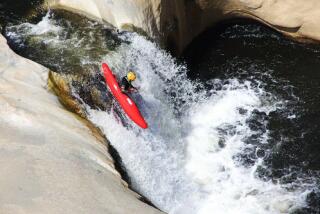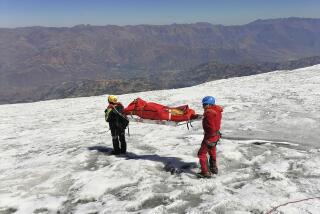Deaths caused by avalanches on the rise
A Lake Tahoe-area resort ski patrol member for nearly 30 years, Bill Foster would have understood the dangers of avalanches better than most. But even knowing the exact date and time of a planned avalanche didn’t save the 53-year-old’s life.
Moments after another member of the ski team set off an avalanche with explosives late Monday morning as part of an effort to reduce the risk of an unpredictable avalanche, Foster was buried in Alpine Meadows. He had taken cover in an area that history had suggested would be safe from the rolling snow.
Instead, the tsunami-like wave of snow crested higher and wider than expected, overwhelming Foster. He was uncovered within minutes, and ski patrol members performed CPR on him, but they weren’t able to save him. His death came on the same day that the body of a 49-year-old snowboarder, Steven Mark Anderson of Truckee, was found by a sheriff’s search dog at the Donner Ski Ranch in Nevada County after an avalanche.
California has a far less fearsome reputation for avalanches than states like Colorado, Montana, Utah, Idaho and Alaska. But the two deaths -- the first of the U.S.’ winter season -- were a stark reminder that danger lurks.
In the last 60 years, avalanche deaths have risen dramatically, largely, some experts say, because of the growing popularity of backcountry skiing and hiking, snowboarding and other activities in places that are prone to avalanches. Last winter 34 fatalities were recorded in the U.S., and the top eight years for avalanche deaths have all been recorded since 1995, according to the Colorado Avalanche Information Center.
Most of the deaths since 1950 have involved people from ages 16 to 45, presumably the fittest and most likely to partake in physical activities like skiing and backcountry hiking. California recorded two avalanche fatalities last year, compared with seven for Colorado, six for Alaska, six for Montana, five for Utah and four each for Washington and Wyoming.
In the 2009-10 season, when the U.S. tallied 36 avalanche deaths, none happened in California, according to the Colorado Avalanche Information Center. But four people died in California in the 2007-08 season, when 36 people in the U.S. perished in avalanches.
John Snook, a forecaster for the information center, said California’s maritime climate makes for large snowstorms and deep, dense snow packs that are more stable than shallower and more stratified snowpacks in states like Colorado.
“Typically in California you’ll get a large snowstorm and the avalanche danger is really elevated for a couple of days and then the danger tends to go back down,” he said.
Snook said the increase in avalanche deaths isn’t explained by more dangerous conditions in mountains. Rather, there has been an increased popularity of activities like backcountry skiing and snowboarding over the years, along with the advance in equipment that makes it easier for more people of varying physical skills to trek to higher elevations, which has put more people in the path of potential avalanches.
“If you look really carefully at the number of fatalities versus the number of people going out into the backcountry,” Snook said, “it’s probably holding stable or even going down.”
Bill Patzert, a climatologist for the Jet Propulsion Laboratory in La Canada Flintridge, said that while the West has been “extremely dry” for the better part of eight months, the Northern Sierra has gotten a lot of snow of late. But the weather has been far from extreme, he said.
“Avalanches have been happening forever,” Patzert said. “Snow plus mountains equals avalanches. That’s not new. What has changed is the higher density of skiers that have pushed the envelope farther and farther up the slopes.”
The avalanche risk was not at its highest when Foster died. According to the Sierra Avalanche Center’s “danger scale,” the risk was considerable, meaning conditions were dangerous, but not very dangerous or extreme, with “natural avalanches likely” instead of possible.
Pete Mann, a spokesman for the California Highway Patrol in Truckee, said warm storms brought heavy, warm snow mixed with shallower, weak base layers from a previous cold front.
It can all add up to marble layers of different consistency that don’t always hold up together well. The alternating weather from cold to warm probably added to the instability of the snow, he said.
Jenny Hatch, a program director for the Sierra Avalanche Center, said that though fatalities are relatively rare, the threat of avalanches isn’t unusual in the Sierra. “Every year we have incidents. Every year we get a lot of slides,” she said. “The take-home message for people is to be aware of conditions and use safe travel when on the mountains.”
Ski resorts try to manage the avalanche danger by triggering some to reduce the chance of unforeseen disaster. That’s what Foster and his ski team were trying to do when he died.
“Bill ... was one of Alpine Meadows’ very best and most experienced professional ski patrollers,” Squaw Valley and Alpine Meadows resorts said in a statement. He had “28 years of experience on Alpine Meadows’ professional ski patrol and he routinely performed snow safety in this area.”
--
More to Read
Sign up for Essential California
The most important California stories and recommendations in your inbox every morning.
You may occasionally receive promotional content from the Los Angeles Times.











